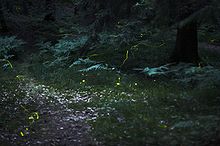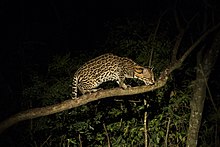Crepuscular animal

In zoology, a crepuscular animal is one that is active primarily during the twilight period,[1] being matutinal, vespertine/vespertinal, or both. This is distinguished from diurnal and nocturnal behavior, where an animal is active during the hours of daylight and of darkness, respectively. Some crepuscular animals may also be active by moonlight or during an overcast day. Matutinal animals are active only before sunrise, and vespertine only after sunset.
A number of factors affect the time of day an animal is active. Predators hunt when their prey is available, and prey try to avoid the times when their principal predators are at large. The temperature may be too high at midday or too low at night.[2] Some creatures may adjust their activities depending on local competition.
Etymology and usage
The word crepuscular derives from the Latin crepusculum ("twilight").[3] Its sense accordingly differs from diurnal and nocturnal behavior, which respectively peak during hours of daylight and darkness. The distinction is not absolute, because crepuscular animals may also be active on a bright moonlit night or on a dull day. Some animals casually described as nocturnal are in fact crepuscular.[2]
Special classes of crepuscular behaviour include matutinal, or "matinal", animals active only in the dawn, and vespertine, only in the dusk. Those active during both times are said to have a bimodal activity pattern.
Adaptive relevance

The various patterns of activity are thought to be mainly
Some predatory species adjust their habits in response to competition from other predators. For example, the subspecies of short-eared owl that lives on the Galápagos Islands is normally active during the day, but on islands like Santa Cruz that are home to the Galapagos hawk, the owl is crepuscular.[5][6]
Apart from the relevance to predation, crepuscular activity in hot regions also may be the most effective way of avoiding heat stress while capitalizing on available light.
Crepuscular flight activity is preferred by some animals, such as the walnut twig beetle, due to warmer temperatures, moderate wind speeds, and low barometric pressure.[7]
Crepuscular activity can be influenced by the lunar cycle due to the change in nocturnal light. This creates changes in animal sleep, reproduction, and foraging behaviours, often becoming less active during periods of low light.[8]
Migration
Animal patterns of activity sometimes change during migration due to changes in environmental conditions. Mule deer are crepuscular, but they are only active at sunset before and during migration. In the spring they are only active at sunrise because the snow is at its hardest, so it is easier for the deer to move without sinking in the snow.[9]
During migration, some types of swallow are active primarily during daytime hours with some activity during twilight hours.[10]
Human impact on crepuscular behaviour
Crepuscular animal activity is affected by human activity, because humans are diurnal. Crepuscular animals are less likely to participate in typical foraging or reproductive behaviors and deal with increased stress and mortality rates when humans are present.[11] Animals may change their usual activity patterns in response to the presence of humans. For example, Asian black bears may avoid areas with high human activity during the day, but go to these locations during twilight or nighttime hours.[12]
Light pollution impacts crepuscular behaviour because it mimics natural light conditions, leading crepuscular animals to behave as they would on nights with more moonlight.[8]
Occurrence of crepuscular behaviour

Many familiar
Crepuscular birds include the common nighthawk, barn owl,[19] owlet-nightjar, chimney swift, American woodcock, spotted crake, white-breasted waterhen,[20] European nightjars,[8] and common buzzards.[21]
Many moths, beetles, flies, and other insects are crepuscular and vespertine.[citation needed]
See also
References
- ^ "Glossary". North American Mammals. Smithsonian – National Museum of Natural History. Archived from the original on May 25, 2017. Retrieved July 16, 2017.
- ^ a b c d e f g "Crepuscular". Macmillan Science Library: Animal Sciences. Macmillan Reference. 2001–2006. Retrieved 2011-07-11.
- ISBN 0415136067.
- ISBN 978-0226094366.
- ^ Frederick, Prince (2006-04-15). "Night herons in the day!". The Hindu. Archived from the original on 2013-01-25. Retrieved 15 January 2012.
- ^ Merck, John. "The community of terrestrial animals". Field Studies II: The Natural History of the Galápagos Islands. University of Maryland Department of Geology. Archived from the original on 23 June 2012. Retrieved 15 January 2012.
- PMID 25157977.
- ^ PMID 32760515.
- S2CID 251695259.
- S2CID 220714544.
- S2CID 22906920.
- S2CID 252985684.
- ISBN 978-1557532459. Retrieved 2012-04-13 – via Google Books.
- ISBN 978-1444361254. Retrieved 2017-06-23.
- ISBN 978-1444361254. Retrieved 2017-06-23.
- ^ Schaul, Jordan Carlton (April 6, 2011). "The Kodiak Cubs Meet Their Neighbors, The American Black Bears". National Geographic Voices. National Geographic Society. Retrieved July 15, 2017.[dead link]
- ^ "White-Tailed Deer". Animals. National Geographic Partners, LLC. 12 March 2010. Archived from the original on October 23, 2016. Retrieved July 15, 2017.
- S2CID 247812966.
- Audubon, John J. (1827–1838). "Plate 171: Barn Owl". Birds of America.
- ^ Boyes, Steve (October 7, 2012). "Top 25 Wild Bird Photographs of the Week #23". National Geographic Voices. National Geographic Society. Archived from the original on May 7, 2017. Retrieved July 15, 2017.
- S2CID 243820248– via Sage Journals.

